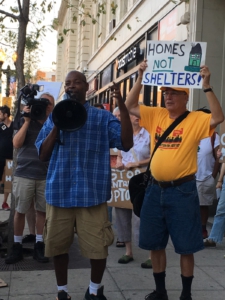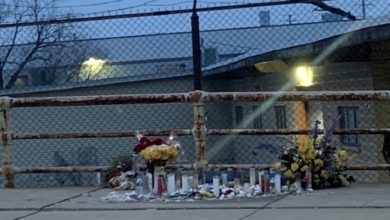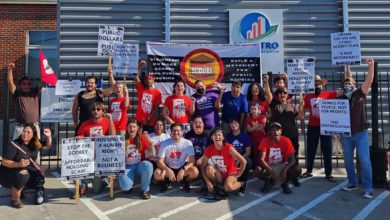 The evening of Sept. 24 was one of those muggy Mondays where you just wanted to stay indoors, preferably with the AC on full blast or lying directly under the ceiling fan or perched right next to the box fan you bought during last year’s dog days of summer just to get the job done. It had gotten up to a scorching 90 degrees earlier that day, a rarity for late September in Chicago. But at 5:30pm, a crowd of about 100 people had gathered outside the office of James Cappleman, Alderman of the 46th ward. Young and old, by foot, bus, car, and train, we converged on his office bearing signs and banners and bullhorns because our friends, residents of Uptown Tent City, couldn’t escape to air-conditioned apartment units on a sweltering afternoon like this. Because our neighbors in Uptown Tent City live outdoors, in tents. And the city of Chicago refuses to let them live in peace.
The evening of Sept. 24 was one of those muggy Mondays where you just wanted to stay indoors, preferably with the AC on full blast or lying directly under the ceiling fan or perched right next to the box fan you bought during last year’s dog days of summer just to get the job done. It had gotten up to a scorching 90 degrees earlier that day, a rarity for late September in Chicago. But at 5:30pm, a crowd of about 100 people had gathered outside the office of James Cappleman, Alderman of the 46th ward. Young and old, by foot, bus, car, and train, we converged on his office bearing signs and banners and bullhorns because our friends, residents of Uptown Tent City, couldn’t escape to air-conditioned apartment units on a sweltering afternoon like this. Because our neighbors in Uptown Tent City live outdoors, in tents. And the city of Chicago refuses to let them live in peace.
Uptown Tent City is a tent city situated proudly on public property in the middle of Uptown, a diverse, working-class neighborhood halfway between North Chicago and the Loop. However, the city of Chicago–with Alderman Cappleman’s blessing–is attempting to change all of that by funneling taxpayers’ money into luxury apartment construction projects. The people who are hit first by this, and the hardest, are those who are currently homeless. The city of Chicago is attempting to violently erase homeless people from Uptown, and they are doing so with the force of the city’s infamous muscle, the Chicago Police Department.
Monday’s action was called to protest the Sept. 19 morning eviction of Uptown Tent City residents from the viaducts in order to begin a six-month construction project to put bike paths on either side of the road through the viaducts. Such a project would narrow the sidewalks along the road and–most importantly–displace the over two dozen homeless people previously living in the Wilson and Lawrence Avenue viaducts. These residents, upon being evicted, were told they could relocate to Pacific Garden Mission, a shelter nearly eight miles south of Uptown. Not only is there a perpetual waiting list for housing, but wait times vary from six months to what is, for some residents, “never.” On top of this, construction for the bike path is slated to begin as early as this very week and, as it is an estimated 6-month construction project, is predicted to end by April 2018. This means that the newly-evicted residents of Uptown Tent City are currently facing the prospect of exposure to a brutal Chicago winter with no home to provide any sort of respite from the elements. This means that Cappleman and his violent policies have sentenced Uptown’s homeless population to death.
Since this summer began, there have already been many police raids and forcible evictions of people living in tents on public property. One example of this is of Uptown Tent City 2, an encampment of about 10 tents occupying a grassy lot near the now-closed Stewart School, directly across the street from Cappleman’s office. After Stewart School became one of 50 schools closed by Chicago Public Schools in 2013, debates around how to repurpose the school building saw offers such as conversion into a $30 million community space or a $23.6 million “mixed-income community” of affordable housing. However, these ideas were scrapped upon the site’s $5.1 million sale to Morning Side Equities Group, an upscale developer seeking to create luxury housing and commercial space in the lot.
From the time of its closure to its eventual sale, the school and surrounding empty green space had been home to a large homeless encampment–an encampment whose residents were evicted on the morning of September 26, 2016, fenced out of the property by police, and blocked from returning. Since most of Chicago’s homeless shelters operate at 95 percent capacity on any given night, residents of Uptown Tent City were forced to move several blocks east, to set up their new homes in the viaducts under Lake Shore Drive. However, even after using CPD to chase tent residents away from the area surrounding the Stewart School, the city did not lessen its attacks on the homeless population. Police officers continue to harass and brutalize tent residents at any and all hours of the day under the guise of “street clean-up.”
As part of his plan to purge homeless residents from the streets of Uptown, Chicago Mayor Rahm Emanuel created the benign-sounding Task Force to Reduce Homelessness, a pilot program that truly lives up to the “force” aspect of its name. The city has shown time and time again that it will never hesitate to use its gun-toting police force to forcibly evict tent residents from their homes. Just last week, Uptown neighborhood’s viaduct residents were evicted “by cops lined up, one gun per tent,” according to activist and Uptown Tent City resident Glitter, as an example to set the precedent that no one is allowed to pitch tents anywhere in Chicago if they are homeless. Chicago’s homeless shelters operate at a 95 percent capacity on any given night, a figure that most tellingly does not include the residents of Uptown Tent City and other outdoor encampments. Where are these citizens, evicted at gunpoint, supposed to go? Where are they to live, if the starting price of these proposed luxury apartment buildings clock in at $1400 per month just for a studio-sized apartment? Why has their alderman willfully turned a blind eye to the plight of his poorer constituents in favor of kickbacks from upscale developers? The answer, my friends, is that Cappleman is more than willing to let homeless people die of exposure to heat, to rain, to Chicago winters–all in the name of gentrification.
Cappleman’s continued attacks on homeless people in Uptown have resulted in senseless death and suffering in our community–whether through police raids or hypothermia through exposure to the infamously fatal Chicago winter. Taxpayers’ money is, by his hand, being diverted from keeping homeless shelters open and going instead directly into the pockets of gentrifiers hell-bent on constructing luxury apartment complexes that no one in such a diverse, multicultural, working-class neighborhood could afford. In the Manifesto of the People’s Congress of Resistance, the first point–ostensibly put forth as the very first point due to its pivotal role in the project laid out by the manifesto–instructs us to “meet social needs and secur[e] the means of life for all (health, food, shelter, and education).” This means fighting for housing as a human right. In the United States, where there are 6 empty homes for every homeless person, there should be no homelessness at all. There would be no homelessness if we were to take this creed to heart and stay in the streets, stay on the front lines in the struggle to build a multinational, multi-gendered working class movement to win back from the heartless capitalists like Cappleman what is rightfully ours.
Everyone deserves a home. A house, some kind of shelter to protect against snow, and sleet, and hail, and rain. A room to return to after a long day and just sit, lie down, be oneself away from the public eye. And so, we keep this point of the Manifesto in our minds as we move forward to organize and build the power of the people–all working-class and oppressed people. The ones with real power. The ones sharing tents and studios and 2- 3- 4-bedrooms, the ones in lower-income neighborhoods, the ones in multicultural and diverse neighborhoods, the ones in neighborhoods with the boot of gentrification ever present, ever poised over their jugular, the ones whom our capitalistic society deems “too poor,” “too undeserving,” “too unsightly” to live wherever they choose.
We’re going to take to the streets and stay in the streets year after year until everyone, regardless of race, gender, orientation, religion, income, physical ability, or anything else the ruling class uses as a metric of “deservingness,” has a home. Because housing is a human right.






